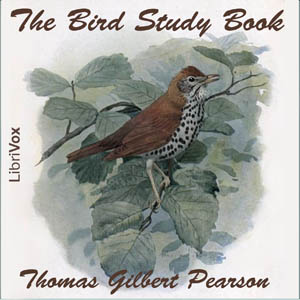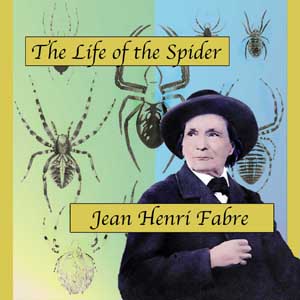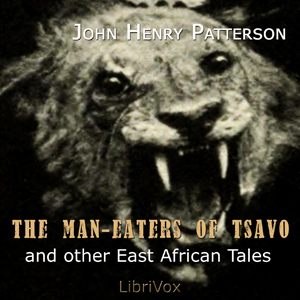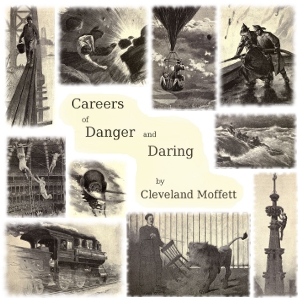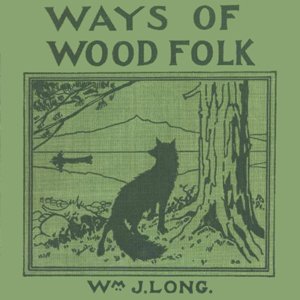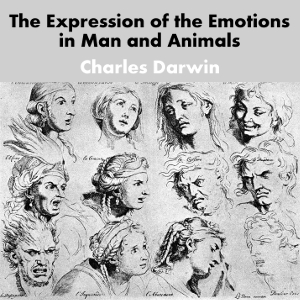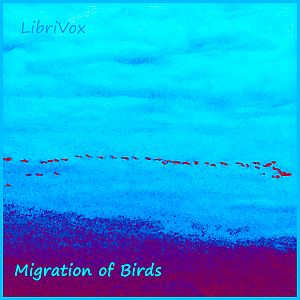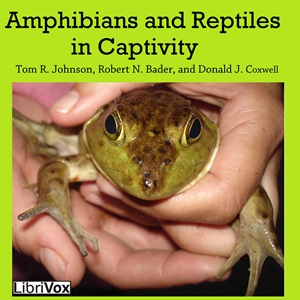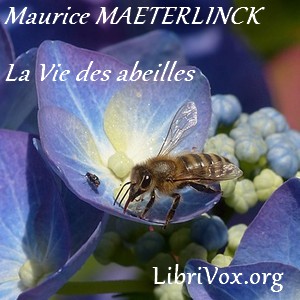"I have known, and loved, and studied many cats, but my knowledge of her (Pretty Lady, a cat) alone would convince me that cats love people--in their dignified, reserved way, and when they feel that their love is not wasted; that they reason, and that they seldom act from impulse."
The thoughts of Helen Winslow, a thoughtful and articulate cat friend, about the cats in her life. (Summary by Karen Merline)
14 episodes
Do you enjoy birdwatching? Would you like to learn a little more about the early conservations efforts to protect wild birds? In the Preface to The Bird Study Book, Pearson tells us “This book was written for the consideration of that ever-increasing class of Americans who are interested in acquiring a greater familiarity with the habits and activities of wild birds. Attention is also given to the relation of birds to mankind and the effect of civilisation on the bird-life of the country. ” An avid ornithologist, T. Gilbert Pearson (1873-1943) was a co-founder in 1905 of the National Association of Audubon Societies of which he was first secretary and then president for many years. He was also a pioneer of the conservation movement in the United States, international bird protection and broad nature education for school-aged children. (Audubon Magazine. 42: 370–371. Nov-Dec 1943)
12 episodes
"Mrs. Beeton's" is a guide to all aspects of running a household in Victorian Britain. Published in 1861, it was an immediate bestseller, running to millions of copies within just a few years. In the cookery sections, Mrs. Beeton follows the animal "from his birth to his appearance on the table.” Learn how to care for poultry during moulting season, how to wean calves, how to cure hams, salt cod, carve mutton, and much more. (Summary by Wikipedia and Sarah Jennings)
108 episodes
Jean-Henri Casimir Fabre was a French entomologist and author. He was born in St. Léons in Aveyron, France. Fabre was largely an autodidact, owing to the poverty of his family. Nevertheless, he acquired a primary teaching certificate at the young age of 19 and began teaching at the college of Ajaccio, Corsica, called Carpentras. In 1852, he taught at the lycée in Avignon. (Summary from Wikipedia)
17 episodes
Squirrels and other Fur-Bearers, a collection of essays by American naturalist and essayist, John Burroughs, provides fascinating insight into the daily life of small woodland creatures. Included in these essays are Burrough's personal observations of squirrels, rabbits, mink, and chipmunks, as well as numerous other small mammals. Highly recommended for anyone, both young and old, with an interest in nature and wildlife. (summary by Laura Caldwell)
15 episodes
Beautiful Joe is a real dog, and "Beautiful Joe" is his real name. He belonged during the first part of his life to a cruel master, who mutilated him in the manner described in the story. He was rescued from him, and is now living in a happy home with pleasant surroundings, and enjoys a wide local celebrity.The character of Laura is drawn from life, and to the smallest detail is truthfully depicted. The Morris family has its counterparts in real life, and nearly all of the incidents of the story are founded on fact. (Summary by Marshall Saunders)
19 episodes
A great dog story, a well told tale--the naturalist and adventurer John Muir recounts how he and his companion, a dog named Stickeen, each, alone, confronted and conquered their fears of an icy Alaskan glacier in 1880. (Summary by Sue Anderson)
3 episodes
Delightful sketches of British wild birds - a bird for every month of the year from the pheasant in January to the robin in December. This collection of articles, reprinted in book form from the periodical The Outlook, is full of fascinating information about bird behaviour and habitat, as well as many interesting anecdotes. (Summary by Ruth Golding)
12 episodes
In By Pond and River, another of Arabella Buckley's wonderful science books for children, she explains the habitats of ponds and rivers, exposing children to the animals and plant life that are found there. (Summary by Laura Caldwell)
13 episodes

Naturalis Historia (Latin for "Natural History") is an encyclopedia published circa AD 77-79 by Pliny the Elder. It is one of the largest single works to have survived from the Roman empire to the modern day and purports to cover the entire field of ancient knowledge, based on the best authorities available to Pliny. The work became a model for all later encyclopedias in terms of the breadth of subject matter examined, the need to reference original authors, and a comprehensive index list of the contents. The scheme of his great work is vast and comprehensive, being nothing short of an encyclopedia of learning and of art so far as they are connected with nature or draw their materials from nature. The work divides neatly into the organic world of plants and animals, and the realm of inorganic matter, although there are frequent digressions in each section. He is especially interested in not just describing the occurrence of plants, animals and insects, but also their exploitation (or abuse) by man, especially Romans. The description of metals and minerals is particularly detailed, and valuable for the history of science as being the most extensive compilation still available from the ancient world. (Summary from Wikipedia)This volume one includes the first five books, covering the following subjects:
Book 1- DedicationBook 2 - An account of the world and the elementsBooks 3 to 5 - An account of countries, nations, seas, towns, havens, mountains, rivers, distances, and peoples who now exist or formerly existed
35 episodes
Cat Tales is the first of a series of kid-friendly collections of animal stories and non-fiction. There'll be one or two grade-school-level texts on the animal, with eight-nine fiction works. Source for these is Project Gutenberg. (Summary by BellonaTimes)
10 episodes
In 1898, during the construction of river-crossing bridge for the Uganda Railway at the Tsavo River, as many as 135 railway workers were attacked at night, dragged into the wilderness, and devoured by two male lions. The Man-Eaters of Tsavo is the autobiographical account of Royal Engineer Lt. Col. J.H. Patterson's African adventures. Among them, his hunt for the two man-eaters.
This book was the basis for the 1996 film The Ghost and the Darkness.
(Summary by James Christopher)
28 episodes
Jock of the Bushveld is a true story by South African author Sir Percy Fitzpatrick when he worked as a storeman, prospector's assistant, journalist and ox-wagon transport-rider. The book tells of Fitzpatrick's travels with his dog, Jock, during the 1880s. Jock was saved by Fitzpatrick from being drowned in a bucket for being the runt of the litter. Jock was very loyal towards Percy, and brave. Jock was an English Staffordshire Bull Terrier. (Summary by Wikipedia)
29 episodes
In this volume of adventure the author depicts the lives of certain humble modern heroes whose unconscious courage ordinarily goes unnoticed. Mr. Moffett
has chosen unusual and picturesque careers, and has offered dramatic scenes from the lives of the steeple climber, the diver, the balloonist,the pilot, the bridge builder, the fireman, the aerial acrobat, the wild animal trainer, the dynamite worker and lastly the locomotive driver. (Summary by annise)And it has great pictures - ever wondered what the top of a steeple really looked like? Some listeners may find the "Wild Animal Tamer" stories distressing - I did. I would suggest you just don't download that section - the rest is well worth listening to.
40 episodes

Naturalis Historia (Latin for "Natural History") is an encyclopedia published circa AD 77-79 by Pliny the Elder. It is one of the largest single works to have survived from the Roman empire to the modern day and purports to cover the entire field of ancient knowledge, based on the best authorities available to Pliny. The work became a model for all later encyclopedias in terms of the breadth of subject matter examined, the need to reference original authors, and a comprehensive index list of the contents. The scheme of his great work is vast and comprehensive, being nothing short of an encyclopedia of learning and of art so far as they are connected with nature or draw their materials from nature. The work divides neatly into the organic world of plants and animals, and the realm of inorganic matter, although there are frequent digressions in each section. He is especially interested in not just describing the occurrence of plants, animals and insects, but also their exploitation (or abuse) by man, especially Romans. The description of metals and minerals is particularly detailed, and valuable for the history of science as being the most extensive compilation still available from the ancient world. (Summary from Wikipedia)This second volume includes books six to ten, covering the following subjects:Book 6 - An account of countries, nations, seas, towns, havens, mountains, rivers, distances, and peoples who now exist or formerly existedBook 7 - Man, his birth, his organization and the invention of the artsBook 8 - The nature of the terrestrial animalsBook 9 - The natural history of fishesBook 10 - The natural history of birds
42 episodes
"Histories are more full of examples of the fidelity of dogs than of friends."
The character, sensibilities, and intellectual faculties of animals have always been a favourite study, and they are, perhaps, more strongly developed in the dog than in any other quadruped, from the circumstance of his being the constant companion of man. I am aware how much has been written on this subject, but having accumulated many original and interesting anecdotes of this faithful animal, I have attempted to enlarge the general stock of information respecting it.
It is a pleasing task, arising from the conviction that the more the character of the dog is known, the better his treatment is likely to be, and the stronger the sympathy excited in his behalf.
(Summary by Edward Jesse, extracted from the Preface)
37 episodes

Naturalis Historia (Latin for "Natural History") is an encyclopedia published circa AD 77-79 by Pliny the Elder. It is one of the largest single works to have survived from the Roman empire to the modern day and purports to cover the entire field of ancient knowledge, based on the best authorities available to Pliny. The work became a model for all later encyclopedias in terms of the breadth of subject matter examined, the need to reference original authors, and a comprehensive index list of the contents. The scheme of his great work is vast and comprehensive, being nothing short of an encyclopedia of learning and of art so far as they are connected with nature or draw their materials from nature. The work divides neatly into the organic world of plants and animals, and the realm of inorganic matter, although there are frequent digressions in each section. He is especially interested in not just describing the occurrence of plants, animals and insects, but also their exploitation (or abuse) by man, especially Romans. The description of metals and minerals is particularly detailed, and valuable for the history of science as being the most extensive compilation still available from the ancient world. (Summary from Wikipedia)This third volume includes books eleven to fifteen, covering the following subjects:Book 11 - The various kinds of insectsBook 12 - The natural history of treesBook 13 - The natural history of exotic trees and an account of unguentsBook 14 - The natural history of the fruit treesBook 15 - The natural history of the fruit trees
26 episodes
A fascinating and classic Victorian ethnology of SE Asia, first published in 1869. The author was co-discoverer of evolution, together with Darwin. (Summary by Nicholas Longhurst)
21 episodes
The Elements of Ornithology is one of seven in a Series of First Books of Natural History Prepared for the Use of Schools and Colleges. This succinct little textbook from 1845 presents an introduction to ornithology. The information, albeit not current, is still interesting and of use as a general overview of bird biology and classification. The author was a surgeon in the U.S. Navy and president of the Academy of Natural Sciences. (Summary by A. Gramour)
12 episodes
The value of the honey bee in cross pollinating the flowers of fruit trees makes it desirable that exact information be available concerning the actions of the bee when gathering and manipulating the pollen. The results recorded in this manuscript are also of value as studies in the behavior of the bee and will prove interesting and valuable to the bee keeper. The work here recorded was done by Dr. Casteel during the summers of 1911 and 1912. (Summary from introduction of manuscript)
10 episodes
Late nineteenth-century naturalist William J. Long invites us in to the secret worlds of the woodland animals. Containing Long's own animal observations along with stories related to him by other humans who inhabit the woods, these stories give us an insight into the behavior of wild animals as they go about their lives in their own secret places deep in the forests of eastern North America. Although Long was accused in his day of anthropomorphizing the animals he wrote about, readers who are familiar with any of the animals he writes of will have glimpses of recognition at behaviors they have seen for themselves and explore the deeper meanings these actions have in that animal's life. The stories will paint pictures in your imagination that will stay with you long after the book has ended. (Summary by Jill Engle.)
18 episodes
The author explores the effects of condensation and evaporation as they relate to the success of a beehive. The results of various experiments and the author's thoughts are given. (Summary by SoMDbeekeeper)
5 episodes
Stories in which ghosts of dogs figure. This is chapter 2, Apparitions Of Dogs, of the book Animal Ghosts Or, Animal Hauntings and the Hereafter.
- Summary by david wales
4 episodes
A collection of seven tales about cats. Caution: Some of these tales have very sad endings. (Summary by MaryAnn)
8 episodes

The 18th century book A Treatise on Modern Falconry is still one of the most quoted books in today's falconry community. The preface was possibly written by a Rev. A. Willis, ridicules "The Origin and Progress of Language," a publication shortly before his writing this book. The introduction to this book gives a historical account of the development of falconry from its beginnings long before the 9th century in the middle East to its apparent decline at the invention of the hunting gun. It also includes interesting facts about the practice of falconry in Persia and Hindostan, where falconry became (and in some parts of the Middle East still is) a sport and pastime of the upper classes. In the second and main part, the book talks about the falconer and his instruments as well as how to treat and train his birds. The book introduces methods of training and handling falcons, hawks and other birds of prey, and also includes sections about their diseases and possible injuries.(Summary by Curt Walton.)
10 episodes
The journal of British naturalist Bruce Frederick Cummings, spanning from his early childhood through to his early death from complications stemming from multiple sclerosis. The diary combines beautiful, lyrical passages concerning the natural world with more introspective ruminations reminiscent of Kafka. Although successful and scandalous upon their publication in 1919, interest in the diaries has faded along with public interest in naturalism and diary writing more generally. However, Cummings' work is very modern is its forthright confessional tone and contains some deeply moving pieces of writing not easily forgotten. - Summary by Adam Whybray
20 episodes
The Expression of the Emotions in Man and Animals is a book by Charles Darwin, published in 1872, concerning genetically determined aspects of behaviour. It was published thirteen years after On the Origin of Species and alongside his 1871 book The Descent of Man, it is Darwin's main consideration of human origins. In this book, Darwin seeks to trace the animal origins of human characteristics, such as the pursing of the lips in concentration and the tightening of the muscles around the eyes in anger and efforts of memory. Darwin sought out the opinions of some eminent British psychiatrists, notably James Crichton-Browne, in the preparation of the book which forms Darwin's main contribution to psychology. - Summary by Availle
27 episodes
The first volume published by the Boone and Crockett Club, entitled "American Big Game Hunting," confined itself to sport on the American continent. This second volume presents a number of interesting sketches written by club members who have hunted big game in other lands. Essays include: Hunting in East Africa, To the Gulf of Cortez, A Canadian Moose Hunt, A Hunting Trip in India, Dog Sledging in the North, Wolf-Hunting in Russia, A Bear-Hunt in the Sierras, The Ascent of Chief Mountain, The Cougar, Big Game of Mongolia and Tibet, Hunting in the Cattle Country, Wolf-Coursing, Game Laws, and Protection of the Yellowstone National Park. - Summary by Michele Fry
24 episodes
This is a delightful collection of stories about a few of the birds, puppies, ant-lions, spiders and other assorted bugs this lady either rescued or found and then observed carefully as they made their way to maturity. She is the most careful as well as compassionate observer of their tiny struggles to live and grow in the real world. Picking up abandoned bird chicks, digging for worms, turning over rocks, this amazing lady shows in every sentence that she loves the entire world of living creatures and then she has a knack of describing it plain language yet entertainingly. Ant-lions, butterflies, baby chicks, puppies, spiders, beetles, earwigs and even snails all fall under her descriptive spell. If you love animals and love to hear about the habits of even the tiniest of them, these short tales are tailor made for you. - Summary by Phil Chenevert
32 episodes
Many books on sports of various kinds have been written, but outside of an occasional article in periodicals devoted to bee literature, but little has been written on the subject of bee hunting. Therefore, I have tried, in this volume, Bee Hunting for Pleasure and Profit, to give a work in compact form, the product of what I have learned along this line during the forty years in nature's school room. - Summary by John Ready Lockard
14 episodes
Enos Mills (1870-1922 ), naturalist and conservationist, was instrumental in the creation of Rocky Mountain National Park. Like his mentor John Muir, Mills was an intrepid solitary high country rambler, as well as an accomplished Colorado mountain guide. There are mountain tales aplenty in "Adventures of a Nature Guide." At one point, Mills climbs Long's Peak alone in a gale with winds topping 170 mph., "carried away with the wild, elemental eloquence of the storm." Near the summit, the wind is so fierce he cannot make headway, so he concludes to "reverse ends." "Putting a shoulder against a rock point, I allowed the wind to push my legs around. This . . . enabled me to brace effectively with my feet, and also to hang on more securely with my hands. . . There was no climbing; the wind sucked, dragged, pushed, and floated me ever upward." Summary by Sue Anderson.
18 episodes
Here is a period piece, covering 47 breeds, about the early days of dog breeding, the birth of the American Kennel Club (1884) which firmly established breed standards, and the development of bench shows and field trials. Each article, written by a premier breed expert of the day, sheds light on how today's breeds were sculpted from the best traits of dogs of yesteryear. Old dog training theory and methods of treating disease are discussed. Editor Shields called this book (as of 1891) “the grandest work on the dog ever published.” Its various authors were part of the movement importing canine stock from Europe, often at enormous expense, and organizing national breed clubs from the various private clubs they were part of. (Summary by Michele Fry)
49 episodes
The reader who follows these trails will find them leading into a new country, a land of space and silence where it is good to be, away up among the mountains and woods and salmon rivers and mossy barren grounds of Labrador and Newfoundland." Indeed, reading Long's keen observations about animals and their behavior transports the reader into a land of nature, space and silence. - Summary by William J. Long, from Preface, and kathrinee.
16 episodes
This book is devoted to the study of invertebrate animals. While most people associate the word "animal" with fish, amphibians, reptiles, birds, and mammals, 90% of the animal species on earth are invertebrates, i.e., they have no backbone. Protozoans and invertebrate animals are found world-wide, from the bottom of the oceans to the the rain forests, ice caves, and our own back yards. Many invertebrates still reside in the oceans, while others dwell in our houses, back yards and gardens, in ponds and streams, and on the menus in seafood restaurants. Holders's book represents a traversal of several dozen familiar and not-so-familiar animals without backbones whose ancestors date back to the Cambrian period 500 million years ago. (Summary by Jefferey Smith)
30 episodes
Snow Geese which left James Bay, Canada, arrived at the Louisiana Gulf coast "60 hours later after a continuous flight of over 1,700 miles at an average speed of 28 miles per hour." This is just one of the many intriguing facts about bird migration contained in this 1998 circular from the U.S. Fish and Wildlife Service. Informative and up-to-date chapters discuss flight speed and rate of migration, migration routes, and techniques for studying migration. A final chapter, Future Directions, concludes "Migratory pathways evolved over the eons in expectation of a moderately stable environment with sufficient food and cover along appropriate corridors that connected sustaining winter ranges with suitable breeding areas... But human impacts on the environment generate rates of change that exceed many species' ability to adapt." Summary by Sue Anderson.
18 episodes
Accented with snatches of verse and a mix of scientific and Christian insight, University of Iowa professor Lazell takes us on vivid nature walks through the rural areas of the Plains state. - Summary by Matt Pierard
3 episodes
Born in rural Vermont in 1833, and nearly unknown to today's readers, Rowland Evans Robinson was once one of Vermont's best-known writers. A talented artist, he drew cartoons in New York City for the “funny papers" before returning to Vermont, where he authored nearly a dozen widely-read books on nature and rural farm life. Poor vision progressed to blindness between the ages of 44 and 60, yet he continued to write with the aid of his wife, Anna. This collection of short essays follows New England's changing seasons and moods in all its natural beauty. - Summary by Nemo
57 episodes
A Book of Whales is a natural history of whales for the layman. - Summary by A. Gramour
26 episodes
The fifth of the Series of First Books of Natural History, embraces that branch of our subject which treats of the Mollusca, or soft animals, and consequently, includes the Elements of Conchology. In the beauty and singularity of their forms, the variety and brilliancy of their colors, shells only yield to flowers…. Limited as this little volume is, it may prove a key to stores of information, even more interesting to many than the numerous fictions of the day. “Truth is stranger than fiction,” has been often said; and the beautiful truths brought to us by a study of animal life, in its various forms, are certainly more admirable and wonderful than any fiction of man’s creation. - Summary by William Ruschenberger
10 episodes
Vivisection is a pejorative term used by opponents of the practice of performing operations on live animals for the purpose of physiological or pathological research. While opposition to the use of living animals for experimentation is most often associated with PETA [People for the Ethical Treatment of Animals, founded in 1980], opposition to use of live animals in physiology research dates back several centuries. Animal experimentation was particularly decried before the development of anesthesia. This book briefly describes the personal histories of twelve prominent critics of live experimentation in 19th century England. - Summary by JefferySmith
14 episodes
Prior to the emergence of paleontology and comparative anatomy as scientific disciplines at the end of the 18th century, it was generally known that there were species of animals that had disappeared completely. The term "extinction" originally applied to the extinguishing of fires or erasing of one's debt. It was not until 1784 that the term extinction was used to denote the complete eradication of a species of living being. In 1901, Frederic A. Lucas penned an overview of vertebrate animals whose only evidence of being remained in fossil records. The book focuses primarily on vertebrate animals, from fish to mammals. - Summary by Jeffery Smith
13 episodes
This succinct little textbook from 1844 presents an introduction to herpetology and ichthyology. The information, albeit not current, is still interesting and of use as a general overview of reptiles, amphibians, and fish. Please note that the classification of the animals may have changed since this time, as well as their environmental status. The step back in time to hear the Victorian view of nature makes it a remarkable read in itself. The author was president of the Academy of Natural Sciences. - Summary by A. Gramour
12 episodes
In recent years the number of people interested in keeping amphibians and reptiles in captivity has grown rapidly. All too often, these same people have little knowledge of the proper care needed for their captives, nor do they know where to turn in order to learn the needs of their animals.
It is the intent of the authors of this special issue to offer the proper information needed to successfully keep amphibians and reptiles in captivity. We are by no means THE experts on the subject, nor do we claim to cover all the facts. However, we do hope that enough information is furnished to answer most of the common questions asked by people.
- Summary by Tom R. Johnson
6 episodes
How to entertain them; with chapters on the destruction of birds, their economic and aesthetic values, suggestions for dealing with their enemies and on the organization and management of bird clubs. - book subtitle. Note: Because of its length and complexity, Mr. Kennard's "sub-chapter" in Chapter 8 entitled "Trees, Shrubs, and Vines Attractive to Birds" has been omitted, but of course is available at the Gutenberg address for this work.
13 episodes
Sir Richard Owen coined the term "dinosaur" ("Terrible Reptile" or "Fearfully Great Reptile") in the 19th century. When Harry G. Seeley, a student of law at that time, attended a lecture on flying reptiles, his interest in paleontology was piqued, and he pursued paleontology for the remainder of his life. He determined that dinosaurs could be divided into two groups, the lizard-hipped dinosaurs and the bird-hipped dinosaurs. He is also credited with characterizing flying dinosaurs as warm-blooded active flyers rather than cold-blooded passive gliders. His popular book on the flying dinosaurs, Dragons of the Air, is a comprehensive treatise on the structure, classification, and possible evolutionary origins of the Pterosaurs as well as their relationship to birds. - Summary by Jeffery Smith
19 episodes
Vie de ces insectes stupéfiants, et aussi philosophie, voire mysticisme..., l'Esprit de la Ruche ... - Summary by Christiane Jehanne
9 episodes
Simple and unpretentious as a statement by Francis d’Assisi, yet full of a gentle modern sophistication and humour, this little work will bring delight and refreshment to all who seek flight from the heavy-laden hour. It is, moreover, one of the most subtle and penetrating studies of the psychology of the dog that has ever been written—tender yet unsentimental, realistic and full of the detail of masterly observation and description, yet in its final form and precipitation a work of exquisite literary art. - Summary from the Foreword by Herman George Scheffauer
10 episodes
The Outline of Science was written specifically with the man-on-the-street in mind as the target audience. Covering scientific subjects ranging from astronomy to biology to elementary physics in clear, concise and easily understood prose, this popular science work is largely as relevant today as when first published in 1922.
In this fourth volume (of four), we learn about bacteria, luminous organisms and lower vertebrates as well as domesticated animals. Other chapters are devoted to ethnology, health, relativity theory and philosophy of science. (Summary adapted from the first three volumes by Availle.)
23 episodes
Charles Sternberg was an American fossil collector and paleontologist. He was active in both fields from 1876 to 1928, and collected fossils for private collectors as well as for international museums. This book is part travelogue, part paleontology, and part historical narrative of life on the open prairie. In it, Sternberg tells of his early interest in fossil hunting as a boy, and scientific expeditions from his first in 1876 to one for the Munich Museum in 1901. - Summary by Ava
14 episodes

